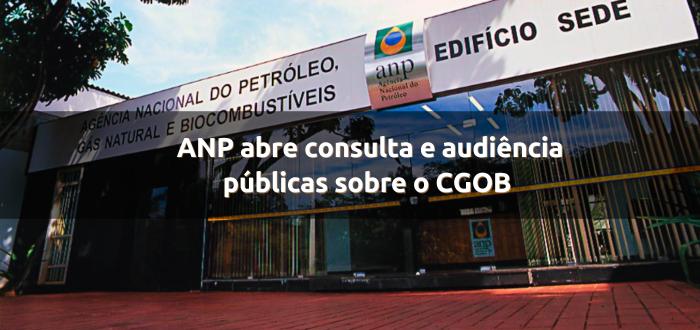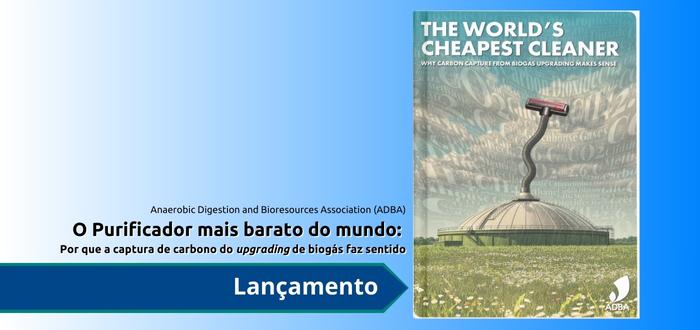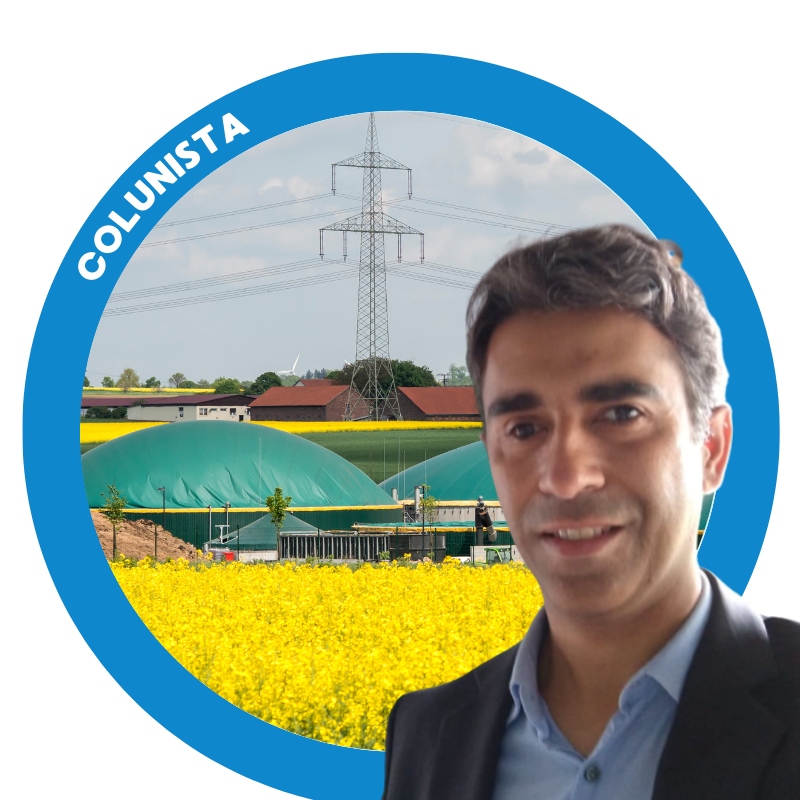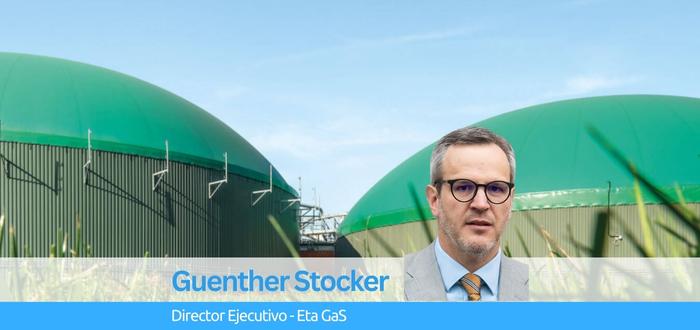Interview with Mr. Günther Stocker
Founder and Owner of Eta GaS Ltd. – Excellence in Anaerobic Digestion
By Oscar Valmanã – Columnist for the Energy and Biogas Portal,
Discover Eta GaS, an Italian company dedicated to enhancing the performance of biogas plants through cutting-edge solutions in anaerobic digestion. The company provides a comprehensive range of services and products, including biological support, process engineering, and high-quality nutritional additives tailored for biogas operations. These additives—formulated with essential micronutrient chelates like iron, nickel, cobalt, and others—were developed by Günther Stocker and produced by a renowned international partner. Eta GaS offers both standardized products for general and silage-based applications, as well as customized solutions. Their additives are designed to be easy to dose, safe, and sustainable, crafted using the finest chelating agents on the market and registered with the European Chemicals Agency (ECHA).
Eta GaS is a company focused on delivering innovative solutions for biogas production. Headquartered in Vipiteno (BZ), its mission is to catalyze and enhance the efficiency of anaerobic digestion by integrating it with complementary renewable technologies, such as Power-to-Liquid. With a global outlook, Eta GaS is committed to driving innovation in renewable energy around the world, while actively promoting the principles of the circular economy and the development of affordable, locally sourced energy.
The company provides a comprehensive range of services and products aimed at maximizing the efficiency and performance of biogas plants. Core offerings include technical support, featuring in-depth analysis to ensure optimal biological processes and maximize economic returns; the supply of premium additives and micronutrients, essential at various stages of anaerobic digestion; and process design, with a focus on developing robust, high-efficiency biomethane plants. Eta GaS also tackles specific operational challenges, such as desulfurization and ammonia inhibition, with specialized chemical treatments and thermally treated natural zeolites.
Eta GaS's mission is to contribute to increasing the efficiency of biogas plants and disseminate innovation in renewable energy worldwide. The company's values include a passion for professional service, commitment, and the courage to bring innovation and certainty to its partners and customers, offering top-quality products, customer-focused services, and reliable technologies. Eta GaS envisions a future where renewable energy sources play a central role in the global economy, where each form is harnessed with maximum efficiency.
Eta GaS envisions a future where highly sustainable renewable energy plays a central role, striving to harness every form of energy with maximum efficiency. The company is driven by core values such as passion, commitment, and courage, which fuel its mission to deliver innovation and reliability to its partners and clients through high-quality products, customer-centric services, and proven technologies.
With a strong emphasis on efficiency and sustainability, Eta GaS positions itself as a strategic player in the global shift toward a circular economy and enhanced local energy autonomy. Its dedication to innovation and continuous improvement makes it a trusted partner for those pursuing advanced, future-ready biogas and renewable energy solutions.
Oscar Valmaña García, columnist for the Energy and Biogas Portal, and Heleno Quevedo de Lima, the portal's founder, sat down for a conversation with Günther Stocker—Executive Manager of Eta GaS, agronomist with a degree in animal nutrition, and a seasoned expert in anaerobic digestion and biogas technologies. During a relaxed discussion, Mr. Günther shared with these interviewers his professional background, his company, corporate culture, and its technological approach, among other topics. Now, they share this inspiring story with the readers of the Energy and Biogas Portal.
INTERVIEW
PERSONAL AND COMPANY PRESENTATION
1) Energy and Biogas Portal: Mr. Günther, could you tell us a little about your training as an agronomist and what inspired you to found Eta GaS?
Mr. Günther: My name is Günther Stocker, and I'm a zootechnical agronomist specializing in bovine nutrition. When I started in the biogas industry in 2006, I immediately saw the commonalities between animal husbandry and biogas technology. One of these commonalities is animal feed, which for a biogas plant is the substrate. In the agricultural sector, I learned that ruminant nutrition is the nutrition of rumen microorganisms, and this same principle applies to an anaerobic reactor. In the anaerobic digestion process, we must focus on specific needs and ideal conditions that improve its efficiency. The bioavailability of micronutrients necessary for microorganisms that cohabit ruminants and share with those in anaerobic reactors is one of those needs and conditions. The use of micronutrient chelate-based additives is my approach to meeting this market need, and it inspired me to found my own company in 2019: Eta GaS Ltd.
The company name comes from linking two terms: Eta, which is the seventh letter of the Greek alphabet (η) and is often used to indicate the performance of a process, and GaS, which is the union of the first two letters of my name and surname (Günther Stocker), and which coincidentally results in the word “gas” when we add an “a” between them, which recalls the word biogas.
At Eta GaS, we emphasize the critical role of a balanced ruminant diet—or in this context, a well-formulated substrate mix—in ensuring the optimal performance of anaerobic reactors in biogas plants. Our expertise lies in accurately diagnosing nutritional deficiencies within the digester by analyzing process variables and assessing micronutrient bioavailability. We address these gaps by delivering state-of-the-art chelated micronutrients, particularly trace elements, tailored to the specific needs of each reactor.
Sharing this knowledge to support the continued growth and success of biogas technology, while helping biogas plants around the world boost their efficiency and revenue, is both inspiring and deeply fulfilling. Equally meaningful is contributing to the global effort to combat climate change, helping safeguard the planet for future generations, including our children.
2) Energy and Biogas Portal: What is Eta GaS's vision for the future of anaerobic digestion and renewable energy?
Mr. Günther: From my perspective, anaerobic digestion can make a huge difference in everyone's daily lives and help combat climate change, from mini-biogas plants in Africa to 1,000 t/d manure biomethane plants in the US; from stillage biogas plants in South America to those using rice straw or pressed sludge in India.
To make a meaningful contribution to the energy transition and the fight against climate change, biogas plants—particularly those operating at an industrial scale—must be designed and managed to achieve and sustain maximum anaerobic reactor efficiency. In this context, Eta GaS tackles the challenge of suboptimal digester performance by expertly balancing and optimizing substrate mixtures and introducing micronutrient additives in the form of highly bioavailable chelates.
Acting as a true "catalyst", Eta GaS delivers innovative, effective solutions that enhance both the efficiency and quality of biogas production. This includes support for advanced facilities pursuing a Power-to-Liquid (PtL) strategy—an approach that leverages renewable electricity, often combined with other energy sources, to produce liquid fuels such as hydrogen, methanol, and others through electrolysis or similar chemical conversion technologies.
At Eta GaS, we firmly believe in the importance of using all forms of renewable energy with maximum efficiency. This is vital to the technological paradigm shift toward sustainable energy production and use. It is also necessary to establish circular, local, simple, and affordable energy concepts worldwide.
Eta Gas's vision is "excellence in anaerobic digestion"—in fact, this is our slogan. We are driven by passion, commitment, and courage to offer innovative and safe solutions to our partners and customers. Through teamwork, we guarantee the best available services and products tailored to the needs of demanding customers. We aim to contribute to improving anaerobic digestion technology, bringing sustainable, cutting-edge solutions to all corners of the world, and establishing valuable, forward-looking global business partnerships.
PRODUCTS AND INNOVATION
3) Eta GaS stands out for using micronutrient chelate and employs cutting-edge chelating agents. Can you explain to our readers what micronutrient chelates are?
Mr. Günther: First and foremost, micronutrients, also known as trace minerals, trace elements, or trace metals, are essential substances that organisms require in minimal amounts, usually measured in parts per million (ppm) or micrograms per gram (mg/g). Despite their minimal presence, they play a crucial role in various biological processes and are vital for maintaining the health and proper functioning of plants, animals, and microorganisms.
Some examples of trace elements include iron (Fe), zinc (Zn), copper (Cu), manganese (Mn), cobalt (Co), molybdenum (Mo), selenium (Se), nickel (Ni), and iodine (I). They all play vital roles in our bodies. Fe, for example, is essential for transporting oxygen in the blood and is involved in various enzymatic reactions; Zn is necessary for immune function, protein synthesis, and as a cofactor for numerous enzymes; Mn is crucial for bone formation, blood clotting, and the metabolism of carbohydrates, amino acids, and
cholesterol; Co is a component of vitamin B12 and is essential for red blood cell production and neurological function; and finally, Mo, which acts as a cofactor for enzymes involved in the metabolism of sulfur-containing amino acids and the detoxification of certain compounds.
Now, when we say chelates, we refer to the chemical union of trace elements with inorganic molecules to form a stable organic complex. Therefore, chelation is a chemical process in which a metal ion, in our case trace metals, binds to a molecule that acts as a chelating agent or ligand, forming a stable structure or complex. This process improves the solubility, stability, and bioavailability of trace elements, making them more accessible and usable by plants, animals, and microorganisms. It occurs naturally and is reproduced by humans at their convenience.
At Eta GaS, we have developed two standardized micronutrient chelates based on cutting-edge superior chelating agents, such as EDDHA (ethylenediamine-N,N'-bis(2-hydroxyphenyl)acetic acid) and synthetic zeolites with high adsorption and ion exchange capacity. We are thus offering the Biogas market innovative, cutting-edge chelates for the seamless integration of micronutrients into all types of biogas plants.
4) How do these products contribute to increasing the efficiency of biogas plants?
Mr. Günther: Excellent question! Can you imagine a cyclist racing the Tour de France without sports drinks?
All biological processes require enzymes, and some enzymes have a micronutrient that plays a role in their functioning. Trace elements are essential micronutrients for the functioning of enzymes in the anaerobic digestion process. Every cell needs macro- and micronutrients to play its role in the process. The number of microorganisms can only increase if the trace elements are bioavailable. The higher the cell count, the better!
Chelate-based trace elements make the biogas plant process more stable, efficient, and highly cost-effective.
5) Why is it important to use chelates or chelating agents to incorporate micronutrients into the anaerobic digestion process?
Mr. Günther: The use of chelates to incorporate micronutrients into the anaerobic digestion process is important for several reasons:
- Promotes bioavailability. Chelating agents bind micronutrients and form highly stable complexes. This improves the solubility and bioavailability of these nutrients, making them more accessible to the microorganisms involved in anaerobic digestion. Many micronutrients may be present in forms that are not easily assimilated by microbes, and chelation helps convert them into easily absorbable forms.
- Preventing precipitation. In anaerobic digesters, certain conditions (such as pH and the presence of other ions) can cause micronutrients to precipitate, making them inaccessible to microorganisms. Chelating agents help keep these nutrients in solution, preventing precipitation and ensuring a constant supply of essential elements for microbial metabolism.
- Provides stability for micronutrient delivery. Chelates can provide a more stable and controlled release of micronutrients over time. This is especially important in anaerobic digestion, where maintaining optimal nutrient levels is crucial for the health and activity of the microbial community and preventing deficiencies that could hinder methane production.
- Mitigates toxicity. Some trace metals in high concentrations can be toxic to microorganisms. Chelating agents can help mitigate this toxicity by binding to these metals and reducing their concentration in the reactor. This allows the beneficial effects of micronutrients to be obtained without harming the microbial populations.
- Improves microbial activity. The presence of essential micronutrients, facilitated by chelation, supports the growth and activity of key microbial populations, particularly methanogens. This can lead to improved digestion efficiency, increased methane production, and improved overall performance of the anaerobic digestion process.
- Enhanced Micronutrient Management. The use of chelates enables more precise and efficient control of micronutrient delivery within anaerobic digesters. This approach allows operators to customize the supplementation of trace elements according to the specific requirements of the microbial community and the composition of the feedstock, ultimately leading to optimized digestion conditions and improved overall plant performance.
- Improve agronomic fertility. Applying digestate with chelated trace elements as a biofertilizer will improve soil health by promoting beneficial microbial activity. A healthy soil microbiome can improve nutrient cycling, organic matter decomposition, and overall soil fertility.
- Toxicity reduction. Non-chelated micronutrient additives can poison digestate, and their use as biofertilizer contaminates the soil. In these cases, trace elements can be toxic to plants at high concentrations and, consequently, to the food chain. Chelating agents can help mitigate this toxicity by binding to excess metals, reducing their bioavailability, and acting as protective agents.
6) Could you explain the concept of trace element bioavailability in the context of anaerobic digestion and why it is so important for the success of the process?
Mr. Günther: The bioavailability of micronutrients, or any other substance necessary for the proper functioning of organisms, encompasses two terms: quantity and chemical form. Thus, for a substance to be considered bioavailable, it must be present in the environment in sufficient quantities required by the cell and in a chemical form that allows for easy absorption and assimilation.
In the context of anaerobic digestion, as in any other biological process, the bioavailability of micronutrients is crucial. Trace elements play a fundamental role in ensuring enzymatic function, microbial growth, and the stability and efficiency of the anaerobic process. But let's briefly explain the main reasons:
- Enzyme activation. Trace elements act as enzyme cofactors that activate the enzymes that catalyze the metabolic reactions of the anaerobic process. For example, iron, nickel, cobalt, manganese, and selenium are essential for the metabolic pathways of methanogenesis, the final phase of methane production.
- Microbial growth and health. Trace elements are vital for the growth and maintenance of healthy microbial communities. A deficiency in trace elements can reduce microbial activity, slowing the digestion process and decreasing methane production and biogas quality.
- Process stability. Adequate bioavailability of trace elements helps maintain a stable anaerobic digestion process. Insufficient levels of trace elements can lead to imbalances in the process, such as the accumulation of volatile fatty acids, which can inhibit microbial activity and reduce methane production.
- Substrate variability. The bioavailability of trace elements varies depending on the type of substrate used in the biogas plant and external factors such as pH, temperature, the presence of chelating agents, agitation, etc. Substrates vary in origin and chemical composition, resulting in variations in the type, chemical form, and quantities of trace elements present. Therefore, understanding the chemical variability of substrates is vital to optimize trace element bioavailability and, consequently, ensure high and stable methane yields.
In short, bioavailability means that micronutrients are immediately and continuously available to microorganisms.
7) You mentioned that trace elements such as nickel, cobalt, manganese, and selenium, for example, play an essential role in methanogenesis. How do these elements contribute to the stability and increase of methane production?
Mr. Günther: As previously mentioned, these trace elements play an important role in anaerobic digestion, particularly as cofactors of certain enzymes involved in the metabolic pathways of methanogenic archaea in the methanogenic phase.
One of the most important enzymes in methanogenesis is methyl-coenzyme M reductase (MCR), which catalyzes the final step in the production of methane from methyl-coenzyme M. This enzyme requires Ni as the cofactor F430 required to produce methane from hydrogen and carbon dioxide (hydrogenotrophic pathway), and without enough this step can be significantly impaired. Mn, as well as Ni, act as cofactors for certain hydrogenases, crucial enzymes that facilitate the conversion of hydrogen gas into protons and electrons and subsequently into methane.
On the other hand, Co is an essential component of vitamin B12, a crucial cofactor for several enzymes involved in the acetogenic and methanogenic phases. One of the key enzymes that require vitamin B12 is methylmalonyl-CoA mutase, which is involved in propionate metabolism and other substrates that can be converted into methane.
Se is known to be a component of enzymes involved in redox reactions. In some methanogenic archaea, Se can be incorporated into selenoproteins, which are proteins containing selenocysteine, an amino acid essential for the function of various enzymes. Se also possesses antioxidant properties that may help protect methanogenic microorganisms from oxidative stress. This is important because the anaerobic environment can sometimes lead to the production of reactive oxygen species. Se also plays an important role in the acetogenic phase and is essential for cellulase enzymes.
While the importance of commonly used trace elements is well established, the roles of Mo and tungsten (W) are less widely recognized. These elements are essential for enzymes such as formylmethanofuran dehydrogenase, which catalyzes the first step in the hydrogenotrophic methanogenesis pathway. Specifically, both molybdenum-dependent and tungsten-dependent enzymes (molybdenum formylmethanefuran dehydrogenase and tungsten formylmethanefuran dehydrogenase) have been identified in Methanobacterium thermoautotrophicum, a species of thermophilic archaea. Ensuring the bioavailability of Mo and W can therefore enhance methane production from hydrogen and carbon dioxide, favoring hydrogenotrophic methanogens over sulfate-reducing bacteria, which otherwise compete for hydrogen to produce hydrogen sulfide.
In my opinion and experience, Mo is certainly important; however, W does not need to be integrated, and only very few experts give W an essential role. Bioavailable Mo also participates in the reduction of hydrogen sulfide with the release of hydrogen. This promotes methane production, as the released hydrogen can be used as a substrate in the hydrogenotrophic pathway.
SUCCESS STORIES AND INTERNATIONAL EXPERIENCE
8) Eta GaS has already carried out projects in various countries, such as Germany and Italy. Do you have any experience or case studies that you consider particularly relevant to the Brazilian market?
Mr. Günther: I can refer to a case study conducted in 2020 with a German client, which I often use to illustrate the importance of using nutritional additives to increase anaerobic process efficiency, methane productivity, and biogas plant profitability. This example can be perfectly applied to biogas plants in Brazil.
A German client operating a co-digestion biogas plant—primarily using a feedstock mix of 65% corn and grass silage and 35% pig manure—began experiencing rising operational costs driven by increased substrate consumption and low methane yields. Seeking a solution, the client turned to Eta GaS for support. After conducting a thorough diagnosis of process variables and assessing the bioavailability of macronutrients and trace elements within the anaerobic reactors, several imbalances were identified.
Notable issues included elevated pH and volatile fatty acid levels, insufficient removal of chemical oxygen demand, and excess concentrations of ammonia, hydrogen sulfide, and potassium. Additionally, we found phosphorus (P) deficiency, very low Se levels, and excessively high concentrations of Cu and Zn. Such imbalances are typical in digesters processing feedstocks with a high proportion of lignocellulosic material, as was the case in this facility.
We solved the problem by dosing our trace element chelates into the reactors. After three months of treatment and monitoring of process variables and macro- and micronutrient values, we verified their correctness. As a result, corn silage consumption (the most valuable and expensive input) decreased by more than 14%: 1.8 tons less in two months, a savings of almost €100 per day. In less than three months, by adding only 24 kg of chelates per dose, the client achieved a cost-benefit ratio of 1/5, meaning a gain of €5 for every euro invested.
Looking at the Brazilian market, I see several interesting sectors, especially agriculture and the sugar and alcohol production industries, where Eta GaS products can contribute to increasing the productivity and profitability of existing biogas plants. Efficient and cost-effective facilities are key to ensuring that biogas technology is viewed optimistically and can continue to expand. The approach offered by Eta GaS is crucial for this. We would love to share our experience in Brazil, especially to ensure that the mistakes made in Europe are not repeated there. We don't have much time to save our planet.
9) The company also has experience in customized applications. How can customized solutions benefit biogas plants using typical Brazilian inputs, such as sugarcane residue and vinasse?
Mr. Günther: More than 12 years ago, I began developing customized products: a specific production for each biogas plant, to ensure that specific needs could be met as quickly and efficiently as possible. I currently have two standard products, but for sugarcane residue and vinasse, a study and a non-standardized proposal are required. This ensures I adhere to my slogan: "add as little as possible."
Between 2013 and 2019, I founded the Biological Service at Bietifin Srl, an organization registered with the National Association of Sugar Beet Cultivation (CNB) in Bologna, Italy. During those years, I learned in-depth about the industrial production of sugar and alcohol, and the problems faced by biogas plants in this sector. However, each substrate has a different chemical composition and requires a specific evaluation and solution.
10) Why would you recommend using Eta GaS products?
Mr. Günther: Well, the main reason is that my products are the result of almost 25 years of experience in the biogas sector, and of those, 12 are of application experience and testing in thousands of customized productions for all types of biogas plants: organic slaughterhouse waste, olive/orange pomace, vinasse, sludge, silage, etc. I was the first to use micronutrients in anaerobic digestion in Italy in 2007.
The performance and value of Eta GaS products are characterized by the following properties:
- We use the best chelating agents available on the market, which guarantee unique performance in different temperature and pH ranges, maximum stability, and immediate solubility.
- Our solid blend with zeolite makes the product stable at any pH. Its dosage in silage (pH 3.5) or in premix tanks with a pH above 8 is completely indifferent.
- It only takes a few weeks to generate high levels of chelates in the reactor. The addition of stable chelates means that, after releasing their ions, they immediately capture other elements and make them bioavailable.
- Soluble in just a few hours, the product provides all the essential micronutrients. The initial dose allows the reactor's operating volume to be saturated.
- Only 1 to 4 ppm (average range) of products is needed to integrate micronutrients into 1 ton of input material.
- Our combination of high-quality inorganic components and chelates such as EDDHA and zeolite provides a robust mix optimized for rapid and efficient integration.
- We provide our products in biodegradable nylon bags inside sealed buckets and on European pallets, which prevents contact with moisture and makes them easy to transport, handle, and dose.
SUSTAINABILITY AND CIRCULAR ECONOMY
11) Eta GaS's mission is focused on the circular economy. How do you see the application of this concept in emerging markets like Brazil?
Mr. Günther: For me, biogas production technology is a very clear example of the concept of the circular economy. In a biogas plant, waste from various production sectors, which constitutes the end of the production and economic cycle, can be managed and transformed into a renewable source of energy and biofertilizers—the raw materials needed to initiate production and economic cycles.
Methane has a global warming potential 28 times greater than carbon dioxide! Millions of tons of organic waste generated worldwide continue to be managed in landfills and dumps, at best in controlled facilities. However, these waste management technologies contribute significantly to the release of methane into the atmosphere. And Brazil is no exception. As a vast country with an emerging economy that depends heavily on raw material extraction and agricultural production, millions of tons of organic waste generated in this country can and should be managed in biogas plants.
I've learned about the significant progress made in biogas production technologies in Brazil in recent years. I believe the country has significant potential to consolidate its use of these technologies, and I'm confident it will. I hope Eta GaS can contribute to this.
12) In Brazil, the cost of inputs can be a challenge for small and medium-sized producers. How do Eta GaS products help reduce the operating costs of biogas plants?
Mr. Günther: All wastes present an extremely high imbalance in trace elements, and these trace elements are generally not readily bioavailable. Without proper substrate selection, optimization of substrate mixtures, and the use of complementary additives, increased operating costs are inevitable due to reduced methane productivity and increased substrate consumption. Eta GaS trace element chelates are the solution to this problem.
The main benefits that a biogas plant would have from using our products, and which would positively and significantly impact production costs, are:
- They guarantee maximum biological stability of the anaerobic digester.
- Reduced foam formation and acidosis.
- They prevent reductions in methane yield.
- They optimize biogas production, allowing more than 90% of carbon to be transferred to biogas.
- They provide enormous flexibility in biogas plant operation: reducing feed cycles, even to one per day.
- Lower energy consumption and higher biogas production.
- The start-up time of the anaerobic reactor (the time it takes for an anaerobic reactor to reach its proper biological condition) can be reduced by up to 50%.
- Increased productivity and profitability of the facility.
On the other hand, our trace element chelates are highly efficient. On average, we recommend a dosage of 1 to 4 ppm per ton of input substrate. Customers have found that even a small increase in methane production already covers the cost of purchasing our products.
OPPORTUNITIES IN BRAZIL AND LATIN AMERICA
13) Brazil and other Latin American countries have great potential for the application of biogas technology, given their agricultural and livestock production. What is most interesting for Eta GaS in the Brazilian market?
Mr. Günther: I think the most interesting aspect of the Brazilian market for Eta GaS is the large volume that will potentially increase as biogas technologies are implemented. As you mentioned, Latin American countries, and especially Brazil, stand out for the large volume of agricultural and industrial waste they generate, which is not yet being recovered through anaerobic digestion. From small biogas plants in the agricultural sector to large industrial waste management plants, all will be excellent market opportunities for Eta GaS. We can offer reliable products, valuable process designs, problem-solving, and biological support.
INNOVATION AND THE FUTURE OF ANAEROBIC DIGESTION
14) The Power-to-Liquid concept is fascinating. How does anaerobic digestion integrate with these technologies?
Mr. Günther: PtL, like Power-to-Gas or conversion of energy to gas, is part of a broader category called Power-to-X, which focuses on the conversion of electricity into other energy carriers or products.
Unfortunately, anaerobic digestion also produces carbon dioxide, not just methane. With the right additives, carbon dioxide production can be reduced, but the remaining carbon dioxide is a pollutant. However, it still contains a carbon atom. By applying the Power-to-Liquid concept, renewable methanol can be produced, a liquid fuel used in various industrial applications and for maritime transport.
15) What do you think will be the next big innovation in the biogas sector?
Mr. Günther: The use of carbon dioxide will be a game-changer. The more bioproducts that can be obtained and marketed at the biogas plant (biomethane, biohydrogen, carbon dioxide, biofertilizers, etc.), the greater the facility's revenue and profitability will be.
⇒ Tune into Biogas: Listen to Podcast Episodes
FINAL MESSAGE
16) Finally, what message would you like to leave the Brazilian public regarding the importance of investing in innovative technologies, such as Eta GaS, for the development of the biogas sector?
Mr. Günther: I've seen countless biogas plants make the same mistakes we made here in Italy almost 20 years ago. I'll share my experience to ensure the Brazilian biogas market strengthens and becomes more efficient immediately. Don't trust just any supplier; seek more opinions. Invest some money before choosing a distributor. Are you sure you need all the equipment and reactor volume? Are there alternatives?
ACKNOWLEDGMENTS
From the Energy and Biogas Portal, we would like to thank Mr. Günther for the excellent talk and for his generosity in sharing a bit of his company's history, projects, and inspiring vision with our readers. Thank you very much!
Eta GaS offers a comprehensive range of services and products designed to enhance the performance of biogas plants. Its core services include technical support, providing in-depth analysis to ensure biological efficiency and maximize economic returns; the supply of high-quality additives and micronutrients essential at various stages of the anaerobic digestion process; and process design focused on building durable, high-efficiency biomethane plants. Additionally, Eta GaS addresses specific challenges such as desulfurization and ammonia inhibition by applying specialized chemicals and thermally treated natural zeolites. Eta GaS’s mission is to help improve the efficiency of biogas plants and promote renewable energy innovation worldwide. The company's values reflect a passion for professional service, a commitment to innovation, and the confidence to deliver reliable solutions to clients and partners—through high-quality products, customer-focused services, and dependable technologies. Eta GaS envisions a future where renewable energy plays a central role in the global economy, and every renewable source is harnessed with maximum efficiency. With a strong focus on efficiency and sustainability, Eta GaS positions itself as a key player in the transition toward a circular economy and greater local energy independence. Its commitment to innovation and continuous improvement makes it a valuable partner for those seeking advanced solutions in biogas and renewable energy. Learn more at: etagas.eu
Interested in the topic?
Want to learn more about biogas in Brazil?
Author: Oscar Valmanã Published on: May 20, 2025.
This article was not written by the Energia e Biogás Portal. Therefore, all credit and responsibility for its content belong to the author.
The Energia e Biogás Portal provides a space for experts to publish articles, opinion pieces, analyses, or technical content related to the biogas, biomethane, and digestate markets.
All submissions are reviewed by the editorial team, which decides whether they will be published.
The views expressed in this section do not necessarily reflect the opinion of the Energia e Biogás Portal.




 ANP abre consulta e audiência públicas sobre o CGOB
ANP abre consulta e audiência públicas sobre o CGOB O purificador mais barato do mundo
O purificador mais barato do mundo O legado de 2025 e o que esperar de 2026
O legado de 2025 e o que esperar de 2026 O professor como agente de transformação
O professor como agente de transformação
 Biogás e COP30
Biogás e COP30 São Paulo abre consulta pública do PPDE 2034
São Paulo abre consulta pública do PPDE 2034 COP30
COP30




